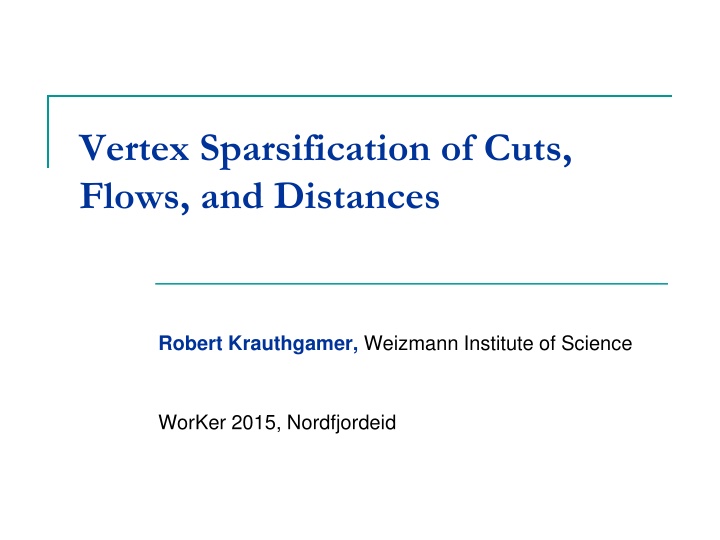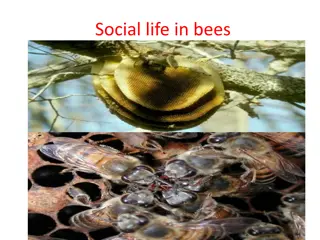
Sparsification of Cuts, Flows, and Distances in Graph Theory
Explore the concepts of sparsification in cuts, flows, and distances in graph theory, focusing on preserving specific features approximately. Topics include edge sparsification, terminal cuts, mimicking networks, and natural questions in the field. Discover results and theorems related to various graph families.
Download Presentation

Please find below an Image/Link to download the presentation.
The content on the website is provided AS IS for your information and personal use only. It may not be sold, licensed, or shared on other websites without obtaining consent from the author. If you encounter any issues during the download, it is possible that the publisher has removed the file from their server.
You are allowed to download the files provided on this website for personal or commercial use, subject to the condition that they are used lawfully. All files are the property of their respective owners.
The content on the website is provided AS IS for your information and personal use only. It may not be sold, licensed, or shared on other websites without obtaining consent from the author.
E N D
Presentation Transcript
Vertex Sparsification of Cuts, Flows, and Distances Robert Krauthgamer, Weizmann Institute of Science WorKer 2015, Nordfjordeid
Graph Sparsification Vast literature on compression (succinct representation) of graphs We focus on preserving specific features distances, cuts, etc. exactly/approximately Edge sparsification: Cut and spectral sparsifiers [Benczur-Karger, , Batson-Spielman- Srivastava] Spanners and distance oracles [Peleg-Schaffer, , Thorup-Zwick, ] Fast query time Graphical representation or mostly Vertex sparsification (keep only the terminal vertices) Cut/multicommodity-flow sparsifier [Moitra, ,Chuzhoy] Distances [Gupta, Coppersmith-Elkin] 2 Vertex Sparsification of Cuts, Flows, and Distances
Terminal Cuts Network G with edge capacities c:E(G) R+. k terminals K V(G) ( huge network) ( important vertices) G: We care about terminal cuts: mincutG(S) = minimum-capacity cut separating S K and S=KnS. (Equivalent to the maximum flow between S and S.) 3 Vertex Sparsification of Cuts, Flows, and Distances
Mimicking Networks A mimicking network of (G,c) is a network (G ,c ) with same terminals and 8 8S K, mincutG(S) = mincutG (S). exact 2 G : G: A 3 5 1 3 9 A B C B 1 C 8 4 Theorem [Hagerup-Katajainen-Nishimura-Ragde 95]. Every k-terminal network has a mimicking network of 22k vertices. Pro: independent of n=|V(G)| Con: more wasteful than listing the 2k cut values (Originally proved for directed networks) Intuition: There are 2k relevant cuts (choices for S), which jointly partition the vertices to 22k buckets ; merge each bucket 4 Vertex Sparsification of Cuts, Flows, and Distances
Natural Questions Narrow the doubly-exponential gap? Better bounds for specific graph families? Represent these cut values more succinctly? Anything better than a list of 2k values? Remark: function mincutG(.) is submodular 5 Vertex Sparsification of Cuts, Flows, and Distances
Our Results [K.-Rika13] Graph Family General graphs Lower Bound 2 (k) Here & indep. by [KR] k+1 [CSWZ] |E(G )| (k2) Here Upper Bound 22k [HKNR] Star graph O(k222k) Here O(k) [CSWZ] Planar graphs Bounded treewidth [Chaudhuri-Subrahmanyam-Wagner-Zaroliagis 98] [Hagerup-Katajainen-Nishimura-Ragde 95] [Khan-Raghavendra 14] Theorem [No succinct representation]: Any storage of the terminal-cut values requires 2 (k) machine words. (word = log n bits) 6 Vertex Sparsification of Cuts, Flows, and Distances
Upper Bound for Planar Graphs Theorem 1. Every planar k-terminal network G admits a mimicking network of size O(k222k); furthermore, this G is a minor of G. Algorithm: merge vertices whenever possible, similarly to [HKNR] Precisely, remove cuts then contract every CC (yields a planar graph) Let ES E be the cutset realizing mincutG(S) [wlog it s unique] Lemma 1a. Removing ES breaks G into k CCs That is, for all S K, |CC(GnES)| k. V: ?? ?? ?? ? . . . ?? ?? ? = {??,??,??} ?? Idea: a CC containing no terminals can be merged with another CC. 7 Vertex Sparsification of Cuts, Flows, and Distances
Two Cutsets Together Lemma 1b. For all S,T K, |CC(Gn(ES[ET))| |CC(GnES)| + |CC(GnET)| + k 3k. (even without planarity) ?? ?? ? ?? ? = {??} ?? ?? ? = {??,??} Idea: Every CC must either contain a terminal or be (exactly) a CC of GnES or of GnET. Otherwise, we can improve one of the cuts. 8 Vertex Sparsification of Cuts, Flows, and Distances
Leveraging Planarity Let ES* be the dual edges to ES. It is a union of cycles (called circuit), at most k of them by Lemma 1a. Lemma 1c. The union S(ES*) partitions the plane into O(k2 22k) connected regions . Idea: By Euler s formula, it suffices to sum up all vertex degrees >2. These are attributed to some intersection ES* & ET*. Every pair S,T contributes O(k2) by Lemma 1b and Euler s formula. 9 Vertex Sparsification of Cuts, Flows, and Distances
Lower Bound for General Graphs Theorem 2. For every k>5 there is a k-terminal network, whose mimicking networks must have size 2 (k). Proved independently by [Khan-Raghavendra 14] Proof Sketch: consider a bipartite graph ? K V ? = 2?/3 ? S = 2k/3 ? ? = ? ?? ? + ? ? Lemma 2a. Each mincutG(S) is obtained uniquely (uS vs. the rest) Thus, each green edge belongs to only one cut. Intuition for next step: Graphs G with few edges have insufficient degrees of freedom to create these 2 (k) cuts. Use linear algebra 10 Vertex Sparsification of Cuts, Flows, and Distances
Lower Bounds Techniques Lemma 2b. The cutset-edge incidence matrix AG has rank(AG) 2 (k). ? ? 1{? mincut ? } mincut(?) ?(?) ? ? = ?? Lemma 2c. WHP, after perturbing capacities to c (add noise2[0, ]), every mimicking network (G',c') satisfies |E(G')| rank(AG). Difficulty: Infinitely-many possible c , cannot take union bound Workaround: Fix G (without capacities c ) and a matrix AG . Pr[ 9c such that (G ,c ) mimicks (G, c ) ] = 0. Union bound over finitely many G and AG . 11 Vertex Sparsification of Cuts, Flows, and Distances
Succinct Representation Theorem 3. Every (randomized) data structure that stores the terminal-cut values of a network requires 2 (k) memory words. Thus, naively listing all 2k cut values achieves optimal storage. Proof Sketch: Use the same bipartite graph. Plant r arbitrary bits by perturbing r edge capacities. Since rank(AG) r, the bits can be recovered from the mincut values. Hence, data structure must have (r) bits. 12 Vertex Sparsification of Cuts, Flows, and Distances
Further Questions About Cuts Close the (still) exponential gap? Perhaps show the directed case is significantly different? Extend the planar upper bound To excluded-minor graphs? To vertex-cuts or directed networks? Extend to multi-commodity flows? A stronger requirement than cuts Smaller network size by allowing approximation of cuts? We already know size is some function s(k), independent of n Our lower bound is not robust 13 Vertex Sparsification of Cuts, Flows, and Distances
Approximate Vertex-Sparsifiers Definition: Quality = approximation-factor guarantee for all cuts Extreme case: retain only terminals, i.e. s(k)=k [Moitra 09] Quality O(log k/loglog k) is possible [Charikar-Leighton-Li-Moitra 10, Makarychev-Makarychev 10, Englert-Gupta-K.-Raecke-TalgamCohen- Talwar 10] And ((log k)1/2/loglog k) is required [Makarychev-Makarychev 10] Goal: constant-factor quality using network size << 22k ? Maybe even (1+ )-quality using size s (k, ) Theorem [Chuzhoy 12]. O(1)-quality using network size CO(log log C) where C is total capacity of edges incident to terminals Note: C might grow with n=|V| 14 Vertex Sparsification of Cuts, Flows, and Distances
Our Results [Andoni-Gupta-K.14] Theorem 4. Bipartite* networks admit (1+ )-quality sparsifiers of size poly(k/ ) Bipartite* = the non-terminals form an independent set Bypasses 2 (k) bound we saw for exact sparsifiers (even in bipartite) Theorem 5. Networks of treewidth w admit O(log w/loglog w)-quality (flow) sparsifiers of size O(w poly(k)) Theorem 6. Series-parallel networks admit exact (quality 1) (flow) sparsifiers of size O(k) 15 Vertex Sparsification of Cuts, Flows, and Distances
Main Idea: Structure Sampling Edge sampling useful for edge-sparsifiers [BK 96,SS 11] But does not work here, need to sample entire sub-structures 16 Vertex Sparsification of Cuts, Flows, and Distances
Sampling in Bipartite Graphs Sample non-terminal vertices, together with incident edges reweight edges accordingly 17 Vertex Sparsification of Cuts, Flows, and Distances
Sampling in Bipartite Graphs Sample non-terminal vertices, together with incident edges reweight edges accordingly Uniform sampling does not work 18 Vertex Sparsification of Cuts, Flows, and Distances
Non-uniform Sampling Non-terminal ? has sampling probability ?? If ? sampled, reweight edges by factor 1/?? Expectation is right: Consider a partition ? = ? ? mincut(?,?) = ?min{? ?,? ,?(?,?)} indicator (w.p. ??) ?? ?? min{? ?,? ,?(?,?)} mincut (?,?) = ? ? ? ? ?,? =1 ? ?,? =2 ? 19 Vertex Sparsification of Cuts, Flows, and Distances
How to choose ?? ? Want ?? ?? min{? ?,? ,?(?,?)} concentrates ? ? 1) mincut (?,?) = ? 2) ??? small i.e. poly Issue: contribution can come from just a few terms 20 Vertex Sparsification of Cuts, Flows, and Distances
Importance sampling ?? ?? min{? ?,? ,?(?,?)} mincut (?,?) = ? Idea 1: Choose ??proportional to contributionmin{? ?,? ,?(?,?)} issue: contribution depends on partition ? ?, but??cannot Idea 2: for any ? = ? ?, large contribution comes from one pair of terminals ? ?,? ? ! mincut ?,? ?min{??,?,??,?} (up to factor ?2) enough to take care of all pairs ?,? 21 Vertex Sparsification of Cuts, Flows, and Distances
Actual Sampling min{??,?,??,?} ?min{??,?,??,?} (thresholded at 1) ??= ? max ?,? oversampling if there were only two terminals ?,?, factor poly(?/?) how important would ? be ? Proof idea: 1) ?? over-estimates the contribution concentration 2) Apply union bound over all choices of cuts ? ? 3) ??? ??2 22 Vertex Sparsification of Cuts, Flows, and Distances
Open Questions Extend to general networks? Want to beat size 22k (exact sparsification) Need to sample other structures (flow paths??) What about flow-sparsifiers? In bipartite networks: (our technique extends) In general networks: no bound s (k, ) is known A positive indication: can build there is a data structure of size (1/ )k2 ( big table with all values) 23 Vertex Sparsification of Cuts, Flows, and Distances
Generalizing Gomory-Hu Trees? Theorem [Gomory-Hu 61]. In every network G, all the minimum ??- cuts can be represented by a tree (on the same vertex set) Surprising redundancy! size O(n) vs. the original graph s O(n2) Desirable extensions: 3-way: represent all minimum {s,t,u}-cuts p-sets: represent all minimum {s1,..,sp}-{t1, ,tp} cuts Any redundancy at all? Theorem 7 [Chitnis-Kamma-K.]. The number of distinct 3-way cuts is O(n2) p-set cuts is O(n2p-1) These bounds are tight But non-constructive and provide no compression 24 Vertex Sparsification of Cuts, Flows, and Distances
Gomory-Hu Tree for Terminals Corollary of [Gomory-Hu 61]. Can represent all terminal ??-cuts (i.e., only ?,? ?) using size O(k) Question: Does it extend to all 3-way cuts? All p-set cuts? Want a bound that depends only on k (not on n) Observe: p-set cuts is a special case of mimicking networks Our bounds on number of distinct cuts extend But they are non-constructive Currently looking at (information-theoretic) lower bounds 25 Vertex Sparsification of Cuts, Flows, and Distances
Terminal Distances Graph G with edge lengths l:E(G) R+. k terminals K V(G) ( important vertices) ( huge network) G: We care about terminal distances: dG(s,t) = shortest-path distance according to l between s,t2K. 26 Vertex Sparsification of Cuts, Flows, and Distances
Distance-Preserving Minor A distance-preserving minor of (G,l) is a minor G with edge-lengths l that contains the same k terminals and 8 8s,t2K, dG(s,t) = dG (s,t). exact 2 G : G: A 3 5 9 12 9 A B C B 1 C 8 4 Why require a minor? To avoid a trivial solution ? 1 1 ? 1 27 Vertex Sparsification of Cuts, Flows, and Distances
Our Results [K.-Nguyen-Zondiner14] We ask: What is the smallest f*(k) such that every k-terminal graph G admits a distance-preserving minor G with |V(G )| f*(k) ? Graph Family ? Trees General Graphs Planar Graphs Treewidth ? Bounds on ? (?,?) = 2? 2 (?2) (?2) (??) ?(?4) ?(?4) ?(?3?) 28 Vertex Sparsification of Cuts, Flows, and Distances
?? ?(??) [Folklore] Naive algorithm: Consider the graph induced by shortest paths between the terminals Eliminate all non-terminals with degree 2 1. 2. Analysis: ?2 shortest-paths between terminals ?4pairs of paths Each pair incurs at most two vertices of degree>2 ( intersections ) ?1 ?2 Thus, number of non-terminals is at most ? ?4 29 Vertex Sparsification of Cuts, Flows, and Distances
?? ?(??) in planar graphs Outline of our original proof: G is a 2-D grid (with specific edge-lengths and terminals) Main lemma: Any G must have a planar separator of size (k) Using the planar separator theorem, |V(G )| (k2) More elementary proof: G is just a (k/4) (k/4) grid Terminals: the boundary vertices In G , horizontal shortest-paths (from left to right terminals) do not intersect Same for vertical shortest-paths Every horizontal path must intersect every vertical path These (k2) intersection points must be distinct Proof extends to (1+ )-approximation, proving |V(G )| (1/ 2). 30 Vertex Sparsification of Cuts, Flows, and Distances
Our Results [Kamma-K.-Nguyen14] Theorem 8. Every k-terminal graph G with edge-lengths l admits a polylog(k) distance-approximating minor of size k. I.e., a minor G containing only the terminals with new edge-lengths l whose terminal-distances approximate G within factor polylog(k). Previously: Approximation factor k is easy Probabilistic approximation factor O(log k) (i.e., by a convex combination of minors) [Englert-Gupta-K.-Raecke-TalgamCohen-Talwar 10] 31 Vertex Sparsification of Cuts, Flows, and Distances
Further Questions About distances: Close the gap (for exact version) between (k2) and O(k4) For general and for planar graphs What about 1+ approximation? Other extreme: Best approximation using a minor of size k? Prove a lower bound of (loglog k)? High-level plan: Maintain other combinatorial properties Discover redundancies (exploit them by data structures?) Matching lower bounds (information-theoretic?) Thank You! 32 Vertex Sparsification of Cuts, Flows, and Distances






















